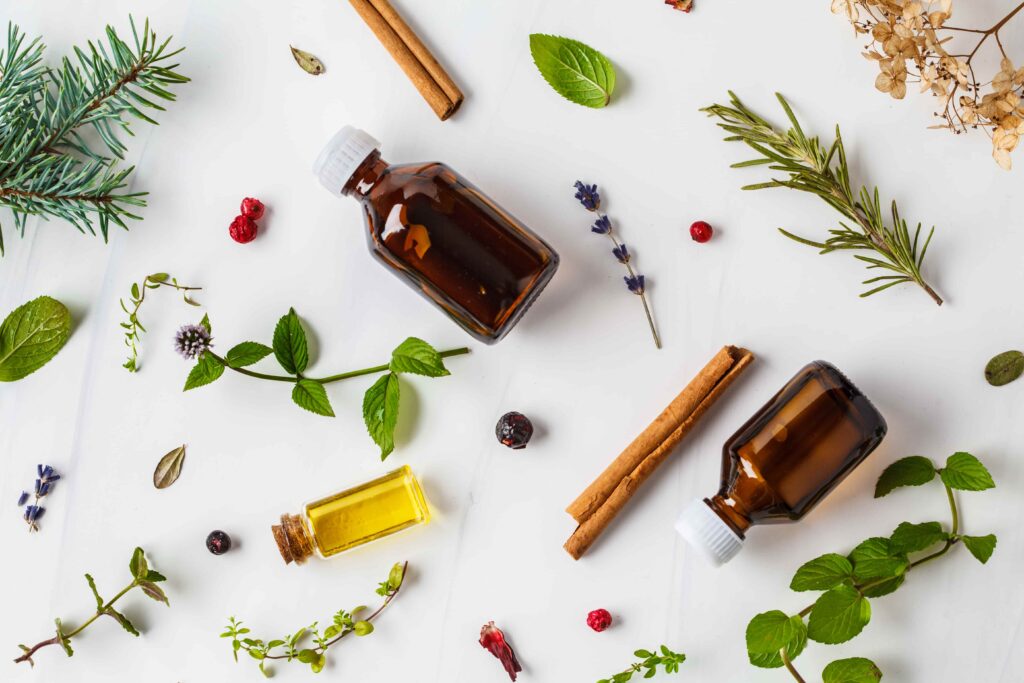
There’s an oil rush in the health and wellness circle. No, not the type that will fuel your cars (although hemp fuel is a thing). We’re talking about plant-based oils, specifically CBD and essential oils. These products often look alike and are extracted in similar ways. With these notable comparisons, it may have you wondering, “Is CBD an essential oil?”
While many of the principles behind essential oils and CBD oil are similar, these two types of products interact with our systems differently — but both can benefit you. Before we celebrate the differences of these plant-based products, let’s discuss the similarities. They begin with the extraction process.
How Are CBD Oil and Essential Oils Extracted?
High-quality CBD and essential oils are extracted in a similar manner. Both involve an extraction process where pressure is applied to the exterior of a plant. The most reputable CBD oil and essential oil companies will use a process known as supercritical CO2 extraction.
This process uses pressurized carbon dioxide. When the CO2 is introduced to the plant molecules, they bind to it. The temperatures in the controlled chamber begin to rise.
The oils within the plant are released into the surrounding atmosphere. From there, the oils can be collected.
What Are Essential Oils?
Essential oils are found within plants, such as fruits, vegetables and herbs. They are made of several chemical compounds found within their plant’s genetic makeup. Plants have evolved to develop thick, protective layers around their essential oils. That’s why you must extract them.
You can find essential oils in different parts of plants including:
Bark
Flowers
Leaves
Peels
Roots
Seeds
Stems
Wood
A majority of these oils contain fragrant molecules known as terpenes. Terpenes are believed to provide the wellness benefits experienced by those who practice aromatherapy.
These viscous liquids are highly volatile, meaning they dissipate as soon as they hit the open air. This is why diffusers are so popular for essential oil users. Molecules in water will trap the essential oils as the diffuser turns the water-oil mixture into a vapor.
What is CBD Oil?
Like essential oils, CBD is also extracted from a plant. Most CBD oil is extracted from hemp, and it also contains a terpene profile of its own. When you purchase broad spectrum or full spectrum hemp extract, many of these terpenes will be present in the formula.
CBD Oil With Terpenes
Some of the terpenes found in hemp that are also present in other essential oils include:
a-Pinene and b-Pinene (Rosemary, clary sage, eucalyptus)
Limonene (Lemon, grapefruit, orange)
Linalool (Lavender, basil, coriander seed)
Myrcene (Lemongrass, juniper, mango)
Beta-caryophyllene (Black pepper, clove bud, cottonseed)
While there are plenty of terpenes found in premium CBD, terpenes aren’t what put CBD products on the map. The most significant difference between CBD oil and essential oils comes down to cannabinoids.
Cannabinoids in CBD Oil
What sets CBD oil apart from essential oils is that hemp is rich in cannabinoids. There are over 100 known cannabinoids found in hemp. Not many other plants are known to have these compounds in their genetic makeup. Because of the superior benefits of these unique compounds, the answer to “Is CBD an essential oil?” would have to be, “No, it’s even better.”
How Does CBD Oil Work?
CBD products have a unique interaction with our system that essential oils can’t claim. That’s because cannabinoids found in hemp complement, and in many ways mirror, the cannabinoids our body creates on its own. These internal cannabinoids are known as endocannabinoids. They are critical components in the endocannabinoid system (ECS).
As endocannabinoids enter the system, they interact with cannabinoid receptors, which in turn helps the ECS regulate the body and mind. Unfortunately, the body has a lot to contend with when it comes to factors that influence these receptors. That’s when CBD oil comes in handy.
When we use CBD oil, cannabinoids indirectly interact with the ECS. This extra bit of plant-based support can help the ECS do what it does best. Therefore, CBD oil promotes homeostasis in a way that essential oils don’t.
How Do Essential Oils Work?
There’s a reason why essential oils are so prevalent in aromatherapy circles. Terpenes in the essential oils activate an area in our body known as the olfactory system. The olfactory system is regulated by the olfactory bulb, which is responsible for your sense of smell.
When you open a bottle of essential oils, you can smell the enticing aromas. These aromatic chemicals contain terpenes that essential oil users depend upon.
As the terpenes enter the nostrils, these plant compounds stimulate thin neural tissues attached to the olfactory bulb. The olfactory bulb will relay this signal to the central nervous system to produce some wellness-promoting effects. For instance, the terpene linalool, found in lavender essential oil, is credited by many as a way to help you feel sleepy.
Why Use CBD Oil and Essential Oils Together?
While CBD isn’t an essential oil, it doesn’t mean that both can’t be part of your everyday wellness routine. In fact, CBD oil and essential oils might even complement one another.
What sets CBD oil and essential oils apart is the presence of cannabinoids in CBD. The cannabinoid content can also set one CBD product apart from another.
When you purchase full spectrum or broad spectrum CBD oil, it means that these products have more cannabinoids in the formula than just CBD. These products elicit an act of synergy within the body known as the entourage effect.
When there are more cannabinoids in the formula, it increases the benefits. Cannabinoids aren’t the only plant compounds that enrich broad spectrum and full spectrum formulas. Terpenes play a big role in the entourage effect as well.
As we mentioned, hemp naturally contains terpenes. Therefore, integrating essential oils into your CBD wellness routine may impact your experience.
Differences in Using Essential Oils and CBD Oil
While CBD oil and essential oils complement one another, you can’t necessarily use them in the same way. The most common way to use CBD oil is in the form of a tincture.
CBD tinctures are formulated by adding the CBD oil extracted from hemp to a fatty oil that’s safe for consumption. At Joy Organics, we use either organic extra-virgin olive oil or medium-chain triglycerides derived from organic coconut oil.
CBD extracts are highly concentrated. Adding this oil to a carrier oil cuts down the intensity of the hemp flavor while healthy fats assist your body in the absorption of plant molecules.
Most CBD products already include a carrier oil so that you can consume them straight from the bottle. The same can’t be said for essential oils. Bottles of essential oils are highly concentrated. Making direct contact with your skin or ingesting pure essential oils can actually lead to burns, allergic reactions or worse.
If you are going to use essential oils for your body, make sure to read up on any particular oil’s effects. If you want to add essential oils to your skincare routine, make sure they are mixed well with a thicker carrier oil. Some of the best carrier oils for cosmetic purposes include jojoba oil, hemp seed oil and sweet almond oil.
How to Use CBD Oil and Essential Oils Together
What’s so great about plant-based care is how customizable it can be. Now it’s easier than ever to integrate CBD oil and essential oils into your wellness routine. Just add CBD and essential oils into the following:
Soaps
DIY shampoos and lotions
Teas
Bath
Sleep masks
Baked goods and frostings
Of course, you can always add essential oils to a diffuser. Water in the diffuser helps cut the intensity of highly concentrated molecules. It also allows for timed release of these particles. You can diffuse your essential oils while you apply your CBD cream or take your CBD softgels for ultimate relaxation!

